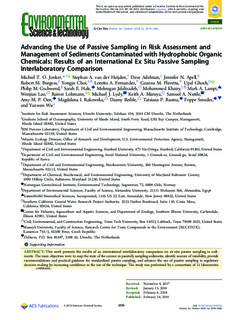| dc.contributor.author | Jonker, Michiel T.O. | |
| dc.contributor.author | van der Heiden, Stephan A. | |
| dc.contributor.author | Adelman, Dave | |
| dc.contributor.author | Apell, Jennifer N. | |
| dc.contributor.author | Burges, Robert M. | |
| dc.contributor.author | Choi, Yongju | |
| dc.contributor.author | Fernandez, Loretta A. | |
| dc.contributor.author | Flavetta, Geanna M. | |
| dc.contributor.author | Ghosh, Upal | |
| dc.contributor.author | Gschwend, Philip M. | |
| dc.contributor.author | Hale, Sarah | |
| dc.contributor.author | Jalalizadeh, Mehregan | |
| dc.contributor.author | Khairy, Mohammed | |
| dc.contributor.author | Lampi, Mark A. | |
| dc.contributor.author | Lao, Wenjian | |
| dc.contributor.author | Lohmann, Rainer | |
| dc.contributor.author | Lydy, M.J. | |
| dc.contributor.author | Maruya, Keith A. | |
| dc.contributor.author | Nutile, Samuel A. | |
| dc.contributor.author | Oen, Amy M P | |
| dc.contributor.author | Rakowska, Magdalena I. | |
| dc.contributor.author | Reible, Danny | |
| dc.contributor.author | Rusina, Tatsiana P | |
| dc.contributor.author | Smedes, Foppe | |
| dc.contributor.author | Wu, Yanwen | |
| dc.date.accessioned | 2018-05-28T08:28:01Z | |
| dc.date.available | 2018-05-28T08:28:01Z | |
| dc.date.created | 2018-03-07T09:28:59Z | |
| dc.date.issued | 2018 | |
| dc.identifier.citation | Environmental Science and Technology. 2018, 52 3574-3582. | |
| dc.identifier.issn | 0013-936X | |
| dc.identifier.uri | http://hdl.handle.net/11250/2499378 | |
| dc.description.abstract | This work presents the results of an international interlaboratory comparison on ex situ passive sampling in sediments. The main objectives were to map the state of the science in passively sampling sediments, identify sources of variability, provide recommendations and practical guidance for standardized passive sampling, and advance the use of passive sampling in regulatory decision making by increasing confidence in the use of the technique. The study was performed by a consortium of 11 laboratories and included experiments with 14 passive sampling formats on 3 sediments for 25 target chemicals (PAHs and PCBs). The resulting overall interlaboratory variability was large (a factor of ∼10), but standardization of methods halved this variability. The remaining variability was primarily due to factors not related to passive sampling itself, i.e., sediment heterogeneity and analytical chemistry. Excluding the latter source of variability, by performing all analyses in one laboratory, showed that passive sampling results can have a high precision and a very low intermethod variability ( | |
| dc.description.abstract | Advancing the Use of Passive Sampling in Risk Assessment and Management of Sediments Contaminated with Hydrophobic Organic Chemicals: Results of an International Ex Situ Passive Sampling Interlaboratory Comparison Michiel T. O. Jonker*† , Stephan A. van der He | |
| dc.language.iso | eng | |
| dc.title | Advancing the Use of Passive Sampling in Risk Assessment and Management of Sediments Contaminated with Hydrophobic Organic Chemicals: Results of an International Ex Situ Passive Sampling Interlaboratory Comparison Michiel T. O. Jonker*† , Stephan A. van der He | |
| dc.title.alternative | Advancing the Use of Passive Sampling in Risk Assessment and Management of Sediments Contaminated with Hydrophobic Organic Chemicals: Results of an International Ex Situ Passive Sampling Interlaboratory Comparison Michiel T. O. Jonker*† , Stephan A. van der He | |
| dc.type | Peer reviewed | |
| dc.type | Journal article | |
| dc.description.version | publishedVersion | |
| dc.source.pagenumber | 3574-3582 | |
| dc.source.volume | 52 | |
| dc.source.journal | Environmental Science and Technology | |
| dc.identifier.doi | 10.1021/acs.est.7b05752 | |
| dc.identifier.cristin | 1571022 | |
| cristin.unitcode | 7452,5,2,0 | |
| cristin.unitcode | 7452,5,1,0 | |
| cristin.unitname | Forurensning og arealutvikling | |
| cristin.unitname | Vann og ressurser | |
| cristin.ispublished | true | |
| cristin.fulltext | original | |
| cristin.qualitycode | 2 | |
